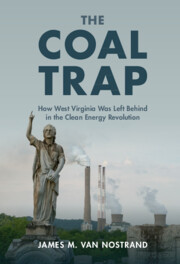Book contents
- The Coal Trap
- The Coal Trap
- Copyright page
- Dedication
- Contents
- Figures and Tables
- Introduction: “The Lost Decade”
- 1 The Rise of Environmental Regulations under Obama’s Environmental Protection Agency
- 2 The Shale Gas Revolution
- 3 The Rise of Renewable Energy
- 4 The “Ds” of Today’s Electric Utility Industry: Decarbonization and Decentralization
- 5 From “Friends of Coal” to the “War on Coal”: How West Virginia Went from Blue to Red
- 6 “Leadership” from Washington, DC: The Congressional Delegation That Could Have but Didn’t
- 7 Manchin in the Middle
- 8 The Failure of the Public Service Commission to Serve the Public
- 9 The Role of the Legislature in West Virginia’s Failed Energy Policies
- 10 Bailing Out the Coal Industry on the Backs of West Virginia’s Electric Ratepayers
- 11 Coal Operators Get Rich and West Virginia Gets to Clean Up the Mess
- 12 What the Future Could Hold if Leaders Choose to Lead
- Acknowledgments
- Index
4 - The “Ds” of Today’s Electric Utility Industry: Decarbonization and Decentralization
Published online by Cambridge University Press: 07 July 2022
- The Coal Trap
- The Coal Trap
- Copyright page
- Dedication
- Contents
- Figures and Tables
- Introduction: “The Lost Decade”
- 1 The Rise of Environmental Regulations under Obama’s Environmental Protection Agency
- 2 The Shale Gas Revolution
- 3 The Rise of Renewable Energy
- 4 The “Ds” of Today’s Electric Utility Industry: Decarbonization and Decentralization
- 5 From “Friends of Coal” to the “War on Coal”: How West Virginia Went from Blue to Red
- 6 “Leadership” from Washington, DC: The Congressional Delegation That Could Have but Didn’t
- 7 Manchin in the Middle
- 8 The Failure of the Public Service Commission to Serve the Public
- 9 The Role of the Legislature in West Virginia’s Failed Energy Policies
- 10 Bailing Out the Coal Industry on the Backs of West Virginia’s Electric Ratepayers
- 11 Coal Operators Get Rich and West Virginia Gets to Clean Up the Mess
- 12 What the Future Could Hold if Leaders Choose to Lead
- Acknowledgments
- Index
Summary
Throughout “the lost decade,” two trends dominated the landscape of the electric utility industry in the United States: decarbonization, or a dramatic reduction in the “carbon footprint” of the typical electric utility, and decentralization, the movement away from the historic, large, centralized generating station model toward greater reliance on smaller, dispersed generating resources – rooftop solar, for example – throughout a utility’s service territory. For the most part, these trends were driven by economics or market forces rather than specific government policies.
With respect to decarbonization, as discussed in Chapter 2, the displacement of coal-fired generation with natural gas-fired combustion turbines throughout “the lost decade” – largely as a result of cheap, plentiful “fracked” gas and improvements in combined-cycle combustion turbine technology – produced significant reductions in greenhouse gas (GHG) emissions from the electric utility industry. Natural gas is twice as clean as coal in terms of carbon emissions when combusted to generate electricity.
- Type
- Chapter
- Information
- The Coal TrapHow West Virginia Was Left Behind in the Clean Energy Revolution, pp. 76 - 96Publisher: Cambridge University PressPrint publication year: 2022



